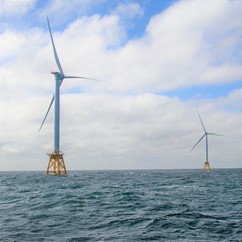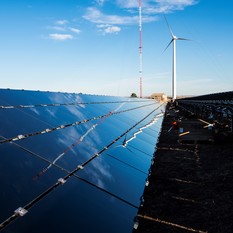 In This Issue
Continue to follow the Wind Energy Technologies Office (WETO) for the latest news, events, and updates.
News

A new, comprehensive approach is now available for evaluating renewable energy project revenue and value holistically. Stakeholders increasingly compare renewable energy technologies based on prices from auctions and power purchase agreements (PPAs), but such face-value price comparisons can be misleading. Auction and PPA prices are often not directly comparable because they come from different value frameworks, jurisdictions or points in time, each reflecting their own markets, taxes, and regulatory environments.
To facilitate more meaningful comparisons, researchers from the U.S. Department of Energy (DOE) and the National Renewable Energy Laboratory (NREL)—in collaboration with international researchers working under the International Energy Agency’s Wind Technology Collaboration Programme—have developed a new approach that uses project revenue and value assessments to facilitate improved “apples-to-apples” comparisons between projects and against established cost metrics.
Read the article in Joule to learn more about how the approach evaluates project revenue and value holistically and about its application to eight global offshore wind projects.
|
On May 13 at the Business Network for Offshore Wind’s International Partnering Forum, DOE Acting Assistant Secretary Kelly Speakes-Backman announced the launch of a comprehensive U.S. offshore wind supply chain roadmap project in partnership with the National Offshore Wind R&D Consortium, NREL, Business Network for Offshore Wind, State of Maryland, and New York State Energy R&D Authority. The project will gather data through the Supply Chain Connect tool—a database, or information clearinghouse, used by developers to search for suppliers and by vendors seeking to introduce themselves to industry. Once the data are robust, NREL will evaluate the results and carry out a detailed analysis of current resources and gaps. The project will also characterize the benefits of strengthening the domestic supply chain and leveraging existing strengths.
“Offshore wind will be an important element of meeting President Biden’s goal to achieve a 100% clean energy economy with net-zero emissions by 2050,” said Kelly Speakes-Backman, DOE’s Acting Assistant Secretary for Energy Efficiency and Renewable Energy. “This project will help us develop a robust domestic offshore wind supply chain that will support tens of thousands of good-paying jobs and spur significant national and regional economic growth.”
As part of the Biden-Harris Administration’s commitment to improving the safety and environmental sustainability of offshore energy development, DOE and the U.S. Department of the Interior’s Bureau of Safety and Environmental Enforcement have entered into a cooperative agreement with Texas A&M Engineering Experiment Station. The university will support the ongoing operation and maintenance of the Ocean Energy Safety Institute (OESI). OESI will manage a research program in support both traditional energy, as well as offshore wind and marine and hydrokinetic energy technologies.

Researchers at NREL have developed FAST.Farm, a new modeling tool for predicting the power performance and structural loads of wind turbines within a wind farm. An extension of the OpenFAST open-source wind turbine engineering tool, FAST.Farm considers the physics of farm-wide ambient wind in the layer of the atmosphere in which wind turbines operate, changes in wake shape with downstream distance, wake movements caused by background turbulence, and farm-wide control. With FAST.Farm, users can simulate the conditions each turbine in a wind farm will need to withstand throughout its lifetime, or they can start fresh and design an entire wind farm to achieve minimal structural load and maximum power production.
FAST.Farm is now available through OpenFAST on GitHub.
|
Upcoming Events
2021 U.S. Department of Energy Collegiate Wind Competition
Virtual: Opening Session, June 2, 2021, 10:30 ET
Virtual: Student Presentations, June 2–4, and June 7–10, 2021
Virtual: National Renewable Energy Lab Flatirons Campus Tour, Industry Networking, Poster Session, and Awards Ceremony, June 11, 2021
Tune in to the 2021 virtual U.S. Department of Energy Collegiate Wind Competition as multidisciplinary university teams present the culmination of their work in wind energy over the past year. These students were challenged to design and test a model wind turbine, plan and financially analyze a wind plant, and create connections with the wind industry and their local communities. Kelly Speakes-Backman, DOE’s Acting Assistant Secretary for Energy Efficiency and Renewable Energy, will kick off the student presentations on Wednesday, June 2. The closing event on Friday, June 11 will include an address from Energy Secretary Jennifer Granholm, an opportunity for viewers to connect with the 2021 competitors at the virtual industry networking event, and an awards ceremony with DOE’s Deputy Assistant Secretary for Renewable Power, Alejandro Moreno. The full schedule and links to the virtual events are available on the CWC website, or you can pre-register through Whova.
CLEANPOWER 2021
Virtual: June 7–10, 2021
Tradeshow and Business Development: Dec 7–8, 2021, Salt Lake City, UT
The American Clean Power Association will host CLEANPOWER 2021, to share information on topics related to utility-scale wind, solar, storage, and transmission in a two-part series: virtual and in person. CLEANPOWER will feature a virtual education and collaboration event June 7–10, followed 6 months later by an in-person conference and exhibition, December 7–8, in Salt Lake City, Utah. The focus for these events is to bring together the different technologies that make up the full complement of the renewable energy mix—land-based wind, offshore wind, solar, storage, and transmission—as well as the different segments within the industries: manufacturers, construction firms, owner-operators, utilities, financial firms, and corporate entities. Register for CLEANPOWER 2021 on the event website.
Overview of Fixed-Bottom Offshore Wind
Virtual Webinar: June 16, 2021, 1:00 pm ET
Join WETO’s WINDExchange initiative for a webinar where NREL offshore wind researcher Walt Musial will introduce offshore wind fixed-bottom foundation technology. The presentation will offer basic technical information, including offshore wind basics, a discussion of foundation types, and construction considerations. More details on this webinar, as well as future wind technology webinars, are available on the WINDExchange website.
International Partnering Forum (IPF) for Offshore Wind
Virtual: IPF Virtual, June 17, 2021
IPF Together: August 24–26, 2021, Richmond, VA
The Business Network for Offshore Wind’s International Partnering Forum (IPF) is being held in a multi-part series: virtual and in person. The series will bring together the global offshore wind industry and offer the latest in education, networking, and platforms to help the offshore wind industry grow. IPF Virtual will take place April 22, May 13, and June 17; the main conference, IPF Together, will take place August 24–26 in Richmond, VA. Agenda and registration details are on the IPF website.
Sandia Blade Workshop
Workshop: October 25–28, 2021, Albuquerque, NM
Sandia National Laboratories issued a “Save the Date” for its 2021 Sandia Blade Workshop, scheduled for October 25–28 in Albuquerque, NM. The workshop convenes wind energy experts from industry, national laboratories, and universities to discuss the research and development of wind turbine blades. For more information, visit Sandia National Laboratories website.
In Case You Missed It
Sharply reducing carbon emissions is imperative to prevent the worst effects of climate change. Yet even in the power sector—often viewed as the lynchpin to economy-wide decarbonization, and where low-carbon solutions are increasingly plentiful and cost effective—the pace and scale of the required transformation can be daunting.

A review of historical trends, however, shows the progress the power sector has already made in reducing emissions. Fifteen years ago, many business-as-usual projections, such as in the Energy Information Administration’s 2005 Annual Energy Outlook, anticipated that annual carbon dioxide (CO2) emissions from power supply in the United States would reach 3,000 million metric tons (MMT) in the year 2020. In fact, direct power-sector CO2 emissions in 2020 were 1,430 MMT—roughly 50% below the earlier projections. By this metric, in only 15 years the country’s power sector has gone halfway to zero emissions. At the same time, electricity bills are lower, costs to human health from air pollution are lower, climate damages from carbon dioxide emissions are lower, and the number of energy jobs is higher than previously projected.
Some factors that have contributed to this success include broad changes to the economy, energy efficiency, more wind and solar power, continued operations of the nuclear fleet, and switching from coal to gas. Achieving a net zero power sector may be challenging, but if the past is any guide, it suggests that further deep reductions are possible.
|
This study was conducted by Berkeley Lab and funded by the Department of Energy's Wind Energy Technologies Office. Read the report and the Berkeley Lab press release.
Wind energy has realized accelerated cost reduction over the last five years—both land-based wind and offshore wind. Recent DOE-funded research gathered input from 140 global experts on technology advancement and cost-reduction opportunities. The work follows a similar expert survey conducted in 2015. The DOE-funded 2020 research shows that experts now expect land-based and offshore wind costs to decline ~35–50% by 2050, resulting in costs 50% lower than predicted in 2015. According to the findings, turbine scale is a key driver for cost reduction. Wind turbines are expected to be 2–3 times larger by 2035, with a median of 5.5 MW for land-based turbines and 17 MW for offshore turbines. As costs decline, industry focus will turn to enhancing the value of wind in energy markets, e.g., through hybridization with storage, and to overcoming deployment barriers. If realized, these expected advancements, cost reductions, and value-enhancement measures will enable wind to play a larger role in energy supply and power-sector decarbonization than previously anticipated.
Read the paper on Berkeley Lab’s website or in Nature Energy.
|